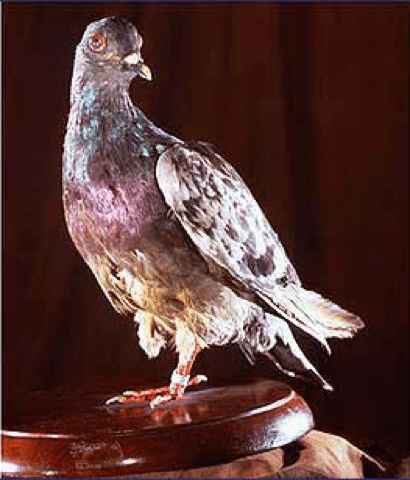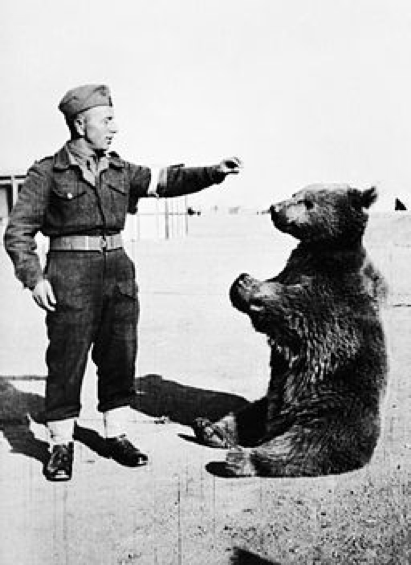November 11th is Veteran’s Day, a holiday in which we should all take a moment to thank those who have risked their life in order to serve in the armed forces. At Chimney and Wildlife Specialists, we often find ourselves dealing with animals in our day-to-day operations. In light of this fact, we thought it would be appropriate to discuss a couple of non-human veterans in today’s post. Here are two stories about animals who served—and showed incredible valor—during the world wars:
Cher Ami
Cher Ami was a homing pigeon employed by the United States 77th Division during World War I. In October of 1918, nine companies in the division—which became known collectively as the “Lost Battalion”—were separated from the rest of their comrades and became trapped behind enemy lines. The battalion, led by Major Charles White Whittlesey, found itself in a nightmarish scenario: as their supplies began to dwindle, the nearby Allied base started firing on their location, unaware that some of their own soldiers were currently hunkered down in the area. Whittlesey’s troops couldn’t escape the barrage because they were surrounded on all sides by German forces.

Their only hope for survival was to get a message to the Allied base via homing pigeon. However, two pigeons carrying messages had already been taken out by German gunfire, so the outlook seemed grim. Whittlesey penned a third, desperate message (“We are along the road paralell [sic] to 276.4. Our own artillery is dropping a barrage directly on us. For heavens [sic] sake stop it.”), and the slip of paper was placed inside of a canister on Cher Ami’s leg. Cher Ami then took flight, with the fate of 194 men resting on her shoulders.
Cher Ami was quickly spotted by German troops, who immediately started shooting at her. The determined bird ignored the hail of gunfire and continued to fly toward her destination, at one point even taking off again after being shot down. About 25 minutes after leaving the Lost Battalion, Cher Ami arrived at the nearby American headquarters. She’d been shot through the breast, blinded in one eye, and one of her legs was dangling by only a few tendons. But attached to that injured leg was the canister containing Major Whittlesey’s message. The American troops subsequently paused their assault on the Lost Battalion’s location, and they were later able to rescue the stranded squadron.
Thanks to the efforts of dedicated medics, Cher Ami survived an additional 11 months after her fateful flight, and she was even fitted with a tiny wooden leg to replace the one she’d lost. The little pigeon returned to America a hero and was awarded a Croix de Guerre (War Cross) by the French government for her actions. She was also posthumously inducted into the Racing Pigeon Hall of Fame in 1931.
(Note: a bit of confusion exists about Cher Ami’s sex. Though she was officially registered as a cock during her lifetime, she was discovered to actually be a hen after her death. Thus, some sources refer to Cheri Ami as male, while others refer to her as female.)
Wojtek (AKA Voytek)
Wojtek was a Syrian brown bear adopted by the Polish military’s 22nd Artillery Supply Company during World War II. As a cub, Wojtek was intended to serve as a pet of sorts for the soldiers; his primary purpose was to boost morale among combatants and give them something to care about. Sure enough, the men came to adore Wojtek, and he adored them right back. Wojtek loved to wrestle and play with the soldiers, and he often delighted them with his antics (including drinking beer out of a bottle and turning on the showers in the communal shower huts). He also learned how to salute on command and march in formation with the rest of the unit.

In order to travel to Europe with the rest of the 22nd Company, Wojtek was officially “drafted” into the Polish army. He was given his own rank, serial number, and paybook. Though he had a special wooden crate for his bedding and transportation needs, the six-foot tall, 500-pound bear spent most of his free time in the tents of his fellow soldiers.
Wojtek showed his true colors during the Battle of Monte Cassino in 1944. At a crucial moment when soldiers under heavy fire desperately needed supplies and the 22nd Company was frantically loading up trucks as fast as possible, Wojtek—who had previously been watching from the sidelines—reportedly stood up on his back legs and approached the supervising officer with outstretched arms. As his fellow infantrymen watched on in amazement, Wojtek took a large crate from the officer, placed it onto a truck, and then quickly came back for another. For days, Wojtek helped load the trucks and haul boxes of supplies (many of which weighed more than 100 pounds), never dropping a single one and seemingly oblivious to the explosions and chaos around him.
Following the Allied victory at Monte Cassino, Wojtek became somewhat of a celebrity in the Polish military. The 22nd Company even adopted the image of a bear carrying an artillery shell as their official emblem. When the war ended in 1945, Wojtek and the rest of his squadron were transferred to a military base in Berwickshire, Scotland. After enjoying a substantial amount of fame and adoration among the locals, Wojtek was gifted to the Edinburgh Zoo in 1947, where he lived out his “retirement” in relative peace and comfort.
(Another Note: some folks have expressed skepticism about Wojtek’s actions during the Battle of Monte Cassino. Notably, the son of Dymitr Szawlugo—one of Wojtek’s caretakers—has reported hearing from another member of the 22nd Company that the bear was actually just made to carry around empty boxes and spent shells as a gesture of solidarity instead of truly “helping” his brothers-in-arms. We’ll let our readers do their own research and draw their own conclusions.)
Biographies of heroic animals could fill a book, and our space here is a bit limited. Please don’t take our focus on Cher Ami and Wojtek as slights against Sgt. Stubby the dog, Reckless the horse, Bill the goat, or any other non-human soldier, as that was not our intention. We simply wanted to share two fascinating stories from the history of warfare.
In closing, to any veterans reading this right now: thank you for your service!

0 responses to “Veterans Day- Hero Animals of World War I and World War II”